You are here
Congressional Budget Office's 2014 Long-Term Budget Outlook
In its 2014 Long-Term Budget Outlook, the nonpartisan Congressional Budget Office (CBO) projects that the federal debt would reach 183 percent of GDP within 25 years. If policymakers do not take action, CBO warns that the rising debt could:
- Reduce real income per person by as much as $5,000 per year
- Reduce private investments in new business equipment and structures
- Crowd out critical public investments in education, R&D, and infrastructure
- Increase the risk of a fiscal crisis, with soaring interest rates and unemployment
- Reduce the flexibility of policymakers to respond to important future events, like wars or recessions
U.S debt held by the public is on an unsustainable path
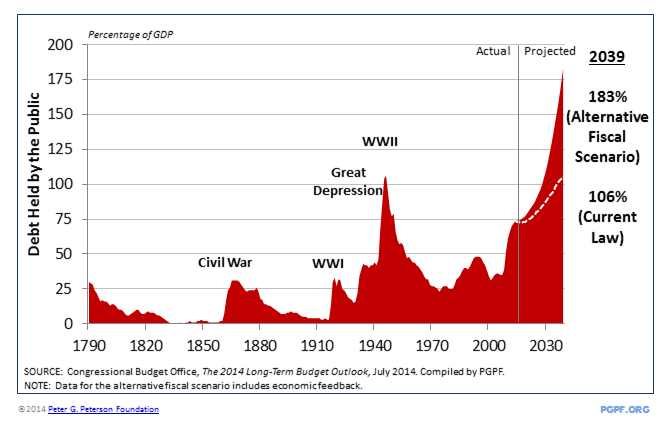
CBO Projects that Federal Debt is on an Unsustainable Path
The July 2014 CBO report on the long-term budget outlook shows that our already high levels of debt will rise significantly in the next 25 years. CBO projects that federal debt will climb from 74 percent of GDP in 2014 to 106 percent of GDP in 2039 (assuming no changes to current law). Based on its less optimistic alternative fiscal scenario and including the feedback effect of rising debt on the economy, CBO projects that debt in 2039 will reach a staggering 183 percent of GDP. (See the box for a description of CBO’s two budget scenarios.)
CBO’s report includes two different budget projections: the current law baseline and the alternative fiscal scenario (AFS). Though the current law baseline is more frequently cited, it provides an optimistic projection of the nation’s fiscal future.
The current law baseline is optimistic because it does not account for changes in current law that are likely to occur in the future. For example, the current law projection assumes that discretionary spending will drop to historically low shares of GDP, a number of popular tax provisions will expire (as scheduled under current law despite the fact that lawmakers have routinely extended those provisions), and that the tax bill for a median family will double within 25 years as real income growth pushes families into higher tax brackets. The current-law baseline also does not incorporate the adverse effects of high levels of debt on the economy.
The alternative fiscal scenario, on the other hand, assumes that lawmakers will enact changes to continue current policies and that rising debts will affect the economy. For example, the AFS assumes that expiring tax breaks will be extended as they have repeatedly been in the past, and that discretionary spending will rise back up to its historical share of GDP in the long run. As a result, deficits and debt under the AFS are projected to be higher than under current laws, painting a less optimistic picture of the long-term debt.
These levels of debt would be unprecedented, adding significantly to the high levels of debt accumulated during the financial crisis and deep 2007-09 recession. Over the past 50 years, debt averaged only 38 percent of GDP and, as recently as 2007, was as low as 35 percent of GDP. Since 1790, our debt has never exceeded 100 percent of GDP, except for a brief time during World War II. After the war, debt fell rapidly as a share of GDP.
Rising Debts Will Harm Our Economy
Our growing debt is not just an abstract problem: it will have serious and far-reaching economic consequences. In its report, CBO warns:
"The projected amounts of debt would reduce the total amounts of national saving and income in the long term; increase the government’s interest payments, thereby putting more pressure on the rest of the budget; limit lawmakers’ flexibility to respond to unforeseen events; and increase the likelihood of a fiscal crisis."
Rising debts will slow the growth of the economy and reduce incomes. CBO estimates that rising debt could reduce average real (inflation-adjusted) income per person by as much as $5,000 in 20391, which represents a 6.4 percent loss in incomes.
The growing federal debt is projected to reduce average income per person by $5,000 in 2039
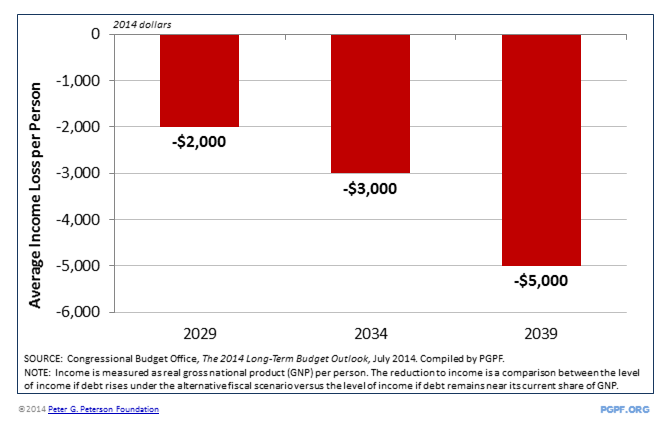
These projections illustrate the critical role that a strong fiscal foundation plays in generating future prosperity. A strong fiscal foundation means that our federal budget has levels of spending and revenues that are in general balance and has a long-term outlook where the debt is stabilized at a reasonable level. A strong fiscal foundation supports favorable economic conditions, including: low interest rates, increased access to capital for individuals and businesses, more private investment, consumer and business confidence, more resources for important public investments in our future, and a solid safety net. With a strong fiscal future, our economy can thrive, reaching its full potential.
Why Does the Debt Grow so Much?
The growth of our long-term debt stems from a structural mismatch between spending and revenue levels. Under current-law assumptions, federal spending is projected to grow from 20.4 percent of GDP in 2014 to 25.9 percent of GDP (4.7 percent of GDP of which is interest) in 2039. Revenues are also projected to increase, but they are not expected to keep pace with rising spending over the next 25 years. CBO projects revenues will rise from 17.6 percent of GDP in 2014 to 19.4 percent of GDP by 2039 — rising above their historical averages, but not by enough to match the growth in spending.
Under an alternative set of assumptions, the mismatch between spending and revenue is even more pronounced. CBO projects that spending, including interest, will soar to 31.4 percent of GDP by 2039, while revenues stabilize at 18 percent of GDP.
The growing debt is caused by a structural mismatch between spending and revenues
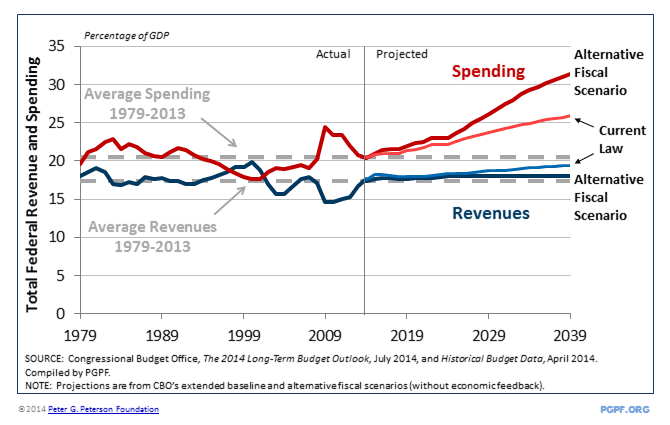
What Drives the Growth of Spending?
Three primary factors drive the increase in spending over the next 25 years: the growing number of retirees who are also living longer, excess growth in healthcare costs, and the expansion of health insurance coverage under the Affordable Care Act (ACA). As a result of these factors, Social Security and major federal health programs (Medicare, Medicaid, Children’s Health Insurance Program, and ACA exchange subsidies) account for 100 percent of the projected growth in non-interest spending — healthcare programs alone account for about 70 percent of that increase.
Spending for major health programs and Social Security are projected to climb rapidly over the long term
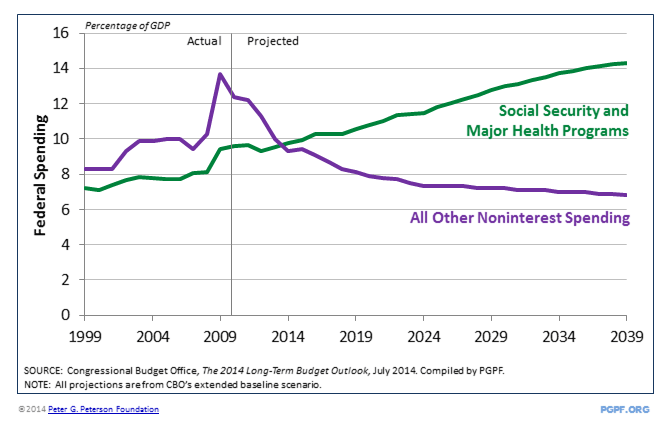
Demographic changes are the primary factor driving cost growth: baby boomers are reaching retirement age, and Americans are living longer. As a result, the number of people receiving Medicare, Medicaid, and Social Security benefits will increase. By CBO’s estimates, aging alone accounts for 55 percent of the total growth of spending on those programs over the next 25 years.
The aging of the baby boom generation will boost the number of Americans age 65 and older
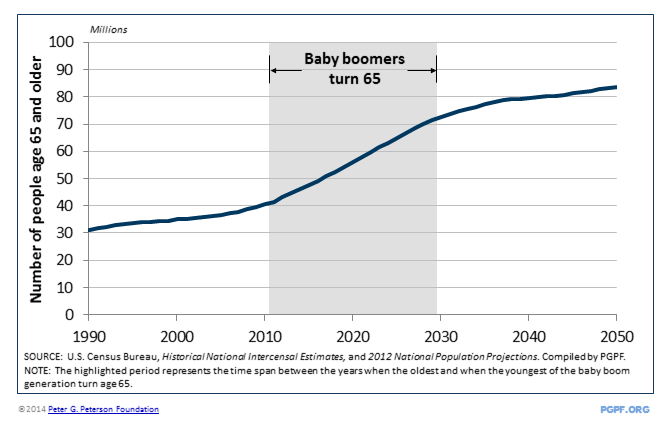
The growth of healthcare costs is the second most important factor in the projected increase in spending, accounting for 24 percent of the spending growth in Social Security and healthcare programs over the next 25 years. Healthcare costs have grown less rapidly in recent years, which is welcome news. Some of this may be due to the weak economy, and some may be due to better efficiency. CBO has incorporated this data on the recent slowdown in growth of healthcare costs into its projections. However, even with these more modest growth projections, CBO projects that current-law spending on major healthcare programs will continue to climb sharply over the next 25 years as a percent of GDP — rising from 4.9 percent of GDP in 2014 to 8.0 percent of GDP by 2039. At that level, health spending would be 31 percent of the total budget.
The third factor behind the projected growth of spending is the expansion of health insurance coverage under the ACA. However, that is largely a near-term driver of costs, according to CBO. Over the next 25 years, it accounts for only about one-fifth of the growth of spending of those programs.
A Growing Interest Burden and Crowding Out
One of the key problems caused by the debt will be staggering interest costs. Over the next 10 years, interest costs alone will add up to $5.8 trillion. By 2019, interest will be the third largest "federal program." Over the long term, under its alternative fiscal scenario, CBO projects that interest costs will climb from 6 percent of the budget in 2014 to 30 percent of the budget in 2050. By 2020, interest costs alone could exceed the historical average of federal spending on education, infrastructure, and R&D combined; by 2050, they are projected to be four times the average spending on those investments.
By 2050, interest costs on the debt are projected to be four times what the federal government has historically spent on education, R&D, and infrastructure combined
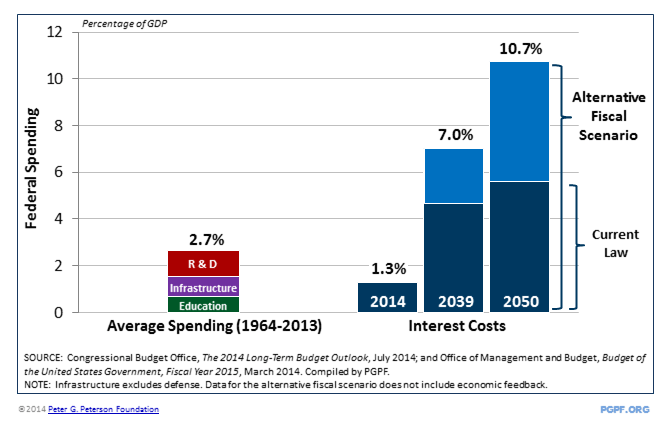
The Need for Action is Clear
While long-term projections are inherently uncertain, the unsustainable fiscal path that we are on requires action. CBO examines projections of the debt under a range of other alternative assumptions and concludes that, “under a wide range of possible expectations for key factors that affect budgetary outcomes, CBO anticipates that if current law generally stayed the same, federal debt in 2039 would be very high by the nation’s historical standards."
One of the uncertainties is how fast healthcare costs will grow. But CBO’s report argues that even if health costs were fully brought under control within 10 years, spending on major healthcare programs would still rise by nearly 40 percent by 2039 due to population aging alone.
Stabilizing Our Fiscal Foundation
Solving our long-term debt problem will require higher taxes, reduced spending, or some combination of the two. CBO estimates that stabilizing the debt-GDP ratio at today's level would require a reduction in current-law deficits (excluding interest) of 1.2 percent of GDP — the equivalent of $225 billion in 2015. If the deficit reduction is split between spending cuts and tax increases, spending would have to be cut — and revenues raised — by about 3¼ percent, on average, over 25 years. To avoid an adverse impact on the near-term economy, the adjustments to spending and revenues could be phased-in over time. Of course, the amount of adjustment required to address the growth in debt would be even larger if policy makers delay taking action, or if they enact policy changes that would increase deficits above their projected path under current law.
The costs of inaction are even greater in terms of the long-term harm to the economy. According to CBO, rising debts will reduce annual income per person by as much as $5,000, crowd out important private and public investments, increase the risk of a fiscal crisis, and reduce the flexibility of policymakers respond to future wars and recessions.
Addressing our debt would also have near-term economic benefits. An agreement on the debt, phased in gradually as the economy recovers, would promote near-term growth by reassuring financial markets and boosting economic confidence and certainty, while also giving people time to plan for and adjust to the changes necessary to secure our fiscal future. A comprehensive long term fiscal plan will give America a solid fiscal foundation, and generate near-term economic growth and long term prosperity.
1That estimate compares income per person under the alternative fiscal scenario with income per person under the scenario that reduces 10-year deficits by $2 trillion and stabilizes debt/GDP at 75 percent in 2039 — roughly its current share. (Back to citation)
